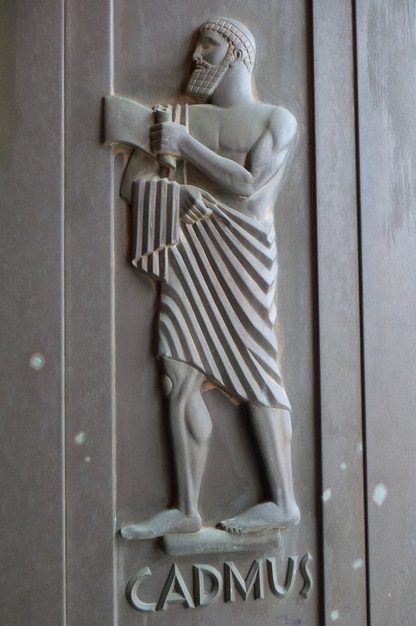Editor’s Note: This is the second chapter of Romulus, by Jacob Abbott (published 1902).
(Continued from Part 1)
II. Cadmus’s Letters
There are two modes essentially distinct from each other, by which ideas may be communicated through the medium of inscriptions addressed to the eye. These two modes are, first, by symbolical, and secondly, by phonetic characters. Each of these two systems assumes, in fact, within itself, quite a variety of distinct forms, though it is only the general characteristics which distinguish the two great classes from each other, that we shall have occasion particularly to notice here.
Symbolical writing consists of characters intended severally to denote ideas or things, and not words. A good example of true symbolical writing is to be found in a certain figure often employed among the architectural decorations of churches, as an emblem of the Deity. It consists of a triangle representing the Trinity with the figure of an eye in the middle of it. The eye is intended to denote the divine omniscience. Such a character as this, is obviously the symbol of an idea, not the representative of a word. It may be read Jehovah, or God, or the Deity, or by any other word or phrase by which men are accustomed to denote the Supreme Being. It represents, in fine, the idea, and not any particular word by which the idea is expressed.
The first attempts of men to preserve records of facts by means of inscriptions, have, in all ages, and among all nations, been of this character. At first, the inscriptions so made were strictly pictures, in which the whole scene intended to be commemorated was represented, in rude carvings. In process of time substitutions and abridgments were adopted in lieu of full representations, and these grew at length into a system of hieroglyphical characters, some natural, and others more or less arbitrary, but all denoting ideas or things, and not the sounds of words. These characters are of the kind usually understood by the word hieroglyphics; though that word can not now with strict accuracy be applied as a distinctive appellation, since it has been ascertained in modern times that a large portion of the Egyptian hieroglyphics are of such a nature as brings them within the second of the two classes which we are here describing, that is, the several delineations represent the sounds and syllables of words, instead of being symbols of ideas or things.

It happened that in some cases in this species of writing, as used in ancient times, the characters which were employed presented in their form some natural resemblance to the thing signified, and in other cases they were wholly arbitrary. Thus, the figure of a scepter denoted a king, that of a lion, strength; and two warriors, one with a shield, and the other advancing toward the first with a bow and arrow, represented a battle. We use in fact a symbol similar to the last-mentioned one at the present day, upon maps, where we often see a character formed by two swords crossed, employed to represent a battle.
The ancient Mexicans had a mode of writing which seems to have been symbolical in its character, and their characters had, many of them at least, a natural signification. The different cities and towns were represented by drawings of such simple objects as were characteristic of them respectively; as a plant, a tree, an article of manufacture, or any other object by which the place in question was most easily and naturally to be distinguished from other places. In one of their inscriptions, for example, there was a character representing a king, and before it four heads. Each of the heads was accompanied by the symbol of the capital of a province, as above described. The meaning of the whole inscription was that in a certain tumult or insurrection the king caused the governors of the four cities to be beheaded.
But though, in this symbolical mode of writing, a great many ideas and events could be represented thus, by means of signs or symbols having a greater or less resemblance to the thing signified, yet in many cases the characters used were wholly arbitrary. They were in this respect like the character which we use to denote dollars, as a prefix to a number expressing money; for this character is a sort of symbol, that is, it represents a thing rather than a word. Our numerals, too, 1, 2, 3, etc., are in some respects of the character of symbols. That is, they stand directly for the numbers themselves, and not for the sounds of the words by which the numbers are expressed. Hence, although the people of different European nations understand them all alike, they read them, in words, very differently. The Englishman reads them by one set of words, the Spaniard by another, and the German and the Italian by others still.
The symbolical mode of writing possesses some advantages which must not be overlooked. It speaks directly to the eye, and is more full of meaning than the phonetic method, though the meaning is necessarily more vague and indistinct, in some respects, while it is less so in others. For example, in an advertising newspaper, the simple figure of a house, or of a ship, or of a locomotive engine, at the head of an advertisement, is a sort of hieroglyphic, which says much more plainly and distinctly, and in much shorter time, than any combination of letters could do, that what follows it is an advertisement relating to a house, or a vessel, or a railroad. In the same manner, the ancient representations on monuments and columns would communicate, perhaps more rapidly and readily to the passer-by, an idea of the battles, the sieges, the marches, and the other great exploits of the monarchs whose history they were intended to record, than an inscription in words would have done.
Another advantage of the symbolical representations as used in ancient times, was that their meaning could be more readily explained, and would be more easily remembered, and so explained again, than written words. To learn to read literal writing in any language, is a work of very great labor. It is, in fact, generally found that it must be commenced early in life, or it can not be accomplished at all. An inscription, therefore, in words, on a Mexican monument, that a certain king suppressed an insurrection, and beheaded the governors of four of his provinces, would be wholly blind and unintelligible to the mass of the population of such a country; and if the learned sculptor who inscribed it, were to attempt to explain it to them, letter by letter, they would forget the beginning of the lesson before reading the end of it,—and could never be expected to attempt extending the knowledge by making known the interpretation which they had received to others in their turn. But the royal scepter, with the four heads before it, each of the heads accompanied by the appropriate symbol of the city to which the possessor of it belonged, formed a symbolical congeries which expressed its meaning at once, and very plainly, to the eye. The most ignorant and uncultivated could readily understand it. Once understanding it, too, they could never easily forget it; and they could, without any difficulty, explain it fully to others as ignorant and uncultivated as themselves.
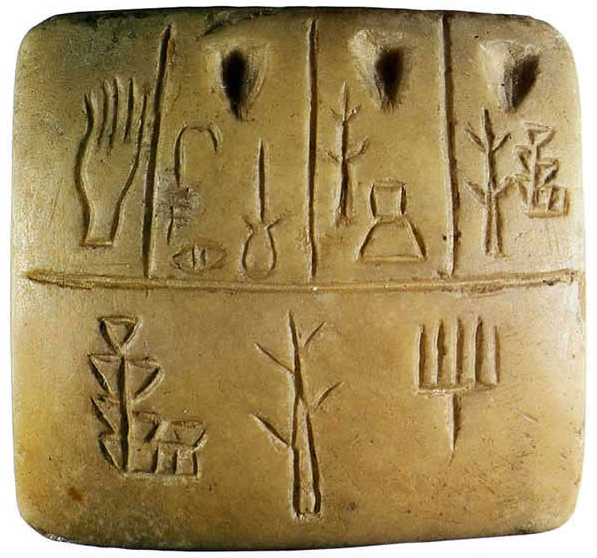
It might seem, at first view, that a symbolical mode of writing must be more simple in its character than the system now in use, inasmuch as by that plan each idea or object would be expressed by one character alone, whereas, by our mode of writing, several characters, sometimes as many as eight or ten, are required to express a word, which word, after all, represents only one single object or idea. But notwithstanding this apparent simplicity, the system of symbolical writing proved to be, when extensively employed, extremely complicated and intricate. It is true that each idea required but one character, but the number of ideas and objects, and of words expressive of their relations to one another, is so vast, that the system of representing them by independent symbols, soon lost itself in an endless intricacy of detail. Then, besides,—notwithstanding what has been said of the facility with which symbolical inscriptions could be interpreted,—they were, after all, extremely difficult to be understood without interpretation. An inscription once explained, the explanation was easily understood and remembered; but it was very difficult to understand one intended to express any new communication. The system was, therefore, well adapted to commemorate what was already known, but was of little service as a mode of communicating knowledge anew.
We come now to consider the second grand class of written characters, namely, the phonetic, the class which Cadmus introduced into Greece, and the one almost universally adopted among all the European nations at the present day. It is called phonetic, from a Greek word denoting sound, because the characters which are used do not denote directly the thing itself which is signified, but the sounds made in speaking the word which signifies it. Take, for instance, the two modes of representing a conflict between two contending armies, one by the symbolic delineation of two swords crossed, and the other by the phonetic delineation of the letters of the word battle. They are both inscriptions. The beginning of the first represents the handle of the sword, a part, as it were, of the thing signified. The beginning of the second, the letter b, represents the pressing of the lips together, by which we commence pronouncing the word. Thus the one mode is symbolical, and the other phonetic.
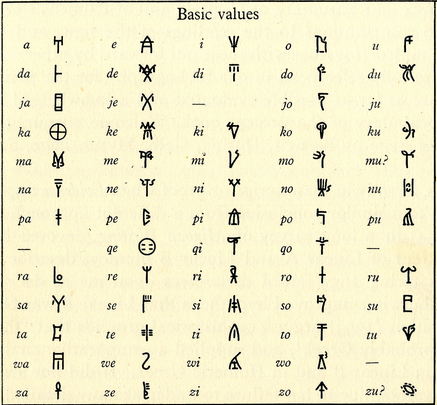
On considering the two methods, as exemplified in this simple instance, we shall observe that what has already been pointed out as characteristic of the two modes is here seen to be true. The idea is conveyed in the symbolical mode by one character, while by the phonetic it requires no less than six. This seems at first view to indicate a great advantage possessed by the symbolical system. But on reflection this advantage is found entirely to disappear. For the symbolical character, though it is only one, will answer for only the single idea which it denotes. Neither itself nor any of its elements will aid us in forming a symbol for any other idea; and as the ideas, objects, and relations which it is necessary to be able to express, in order to make free and full communications in any language, are from fifty to a hundred thousand,—the step which we have taken, though very simple in itself, is the beginning of a course which must lead to the most endless intricacy and complication. Whereas in the six phonetic characters of the word battle, we have elements which can be used again and again, in the expression of thousands of other ideas. In fact, as the phonetic characters which are found necessary in most languages are only about twenty-four, we have in that single word accomplished one quarter of the whole task, so far as the delineation of characters is concerned, that is necessary for expressing by writing any possible combination of ideas which human language can convey.
At what time and in what manner the transition was made among the ancient nations from the symbolic to the phonetic mode of writing, is not now known. When in the flourishing periods of the Grecian and Roman states, learned men explored the literary records of the various nations of the East, writings were found in all, which were expressed in phonetic characters, and the alphabets of these characters were found to be so analogous to each other, in the names and order, and in some respects in the forms, of the letters, as to indicate strongly something like community of origin. All the attempts, however, which have been made to ascertain the origin of the system, have wholly failed, and no account of them goes farther back than to the time when Cadmus brought them from Phoenicia or Egypt into Greece.
The letters which Cadmus brought were in number sixteen. The following table presents a view of his alphabet, presenting in the several columns, the letters themselves as subsequently written in Greece, the Greek names given to them, and their power as represented by the letters now in use. The forms, it will be seen, have been but little changed.
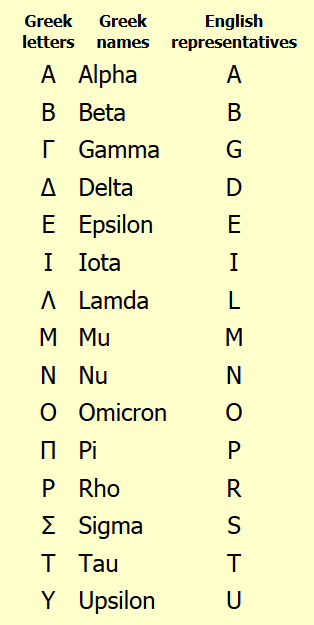
The phonetic alphabet of Cadmus, though so vastly superior to any system of symbolical hieroglyphics, for all purposes where anything like verbal accuracy was desired, was still very slow in coming into general use. It was of course, at first, very difficult to write it, and very difficult to read it when written. There was a very great practical obstacle, too, in the way of its general introduction, in the want of any suitable materials for writing. To cut letters with a chisel and a mallet upon a surface of marble is a very slow and toilsome process. To diminish this labor the ancients contrived tables of brass, copper, lead, and sometimes of wood, and cut the inscriptions upon them by the use of various tools and implements. Still it is obvious, that by such methods as these the art of writing could only be used to an extremely limited extent, such as for brief inscriptions in registers and upon monuments, where a very few words would express all that it was necessary to record.
In process of time, however, the plan of painting the letters by means of a black dye upon a smooth surface, was introduced. The surface employed to receive these inscriptions was, at first, the skin of some animal prepared for this purpose, and the dye used for ink, was a colored liquid obtained from a certain fish. This method of writing, though in some respects more convenient than the others, was still slow, and the materials were expensive; and it was a long time before the new art was employed for any thing like continuous composition. Cadmus is supposed to have come into Greece about the year 1550 before Christ; and it was not until about 650 before Christ, —that is, nearly nine hundred years later, that the art of writing was resorted to in Greece to record laws.
The evidences that writing was very little used in any way during this long period of nine hundred years, are furnished in various allusions contained in poems and narratives that were composed during those times, and committed to writing afterward. In the poems of Homer, for instance, there is no allusion, from the beginning to the end, to any monument or tomb containing any inscription whatever; although many occasions occur in which such inscriptions would have been made, if the events described were real, and the art of writing had been generally known, or would have been imagined to be made, if the narratives were invented. In one case a ship-master takes a cargo on board, and he is represented as having to remember all the articles, instead of making a record of them. Another case still more striking is adduced. In the course of the contest around the walls of Troy, the Grecian leaders are described at one time as drawing lots to determine which of them should fight a certain Trojan champion. The lots were prepared, being made of some substance that could be marked, and when ready, were distributed to the several leaders. Each one of the leaders then marked his lot in some way, taking care to remember what character he had made upon it. The lots were then all put into a helmet, and the helmet was given to a herald, who was to shake it about in such a manner, if possible, as to throw out one of the lots and leave the others in. The leader whose lot it was that should be thus shaken out, was to be considered as the one designated by the decision, to fight the Trojan champion.
Now, in executing this plan, the herald, when he had shaken out a lot, and had taken it up from the ground, is represented, in the narrative, as not knowing whose it was, and as carrying it around, accordingly, to all the different leaders, to find the one who could recognize it as his own. A certain chief named Ajax recognized it, and in this way he was designated for the combat. Now it is supposed, that if these men had been able to write, that they would have inscribed their own names upon the lots, instead of marking them with unmeaning characters. And even if they were not practiced writers themselves, some secretary or scribe would have been called upon to act for them on such an occasion as this, if the art of writing had been at that time so generally known as to be customarily employed on public occasions. From these and similar indications which are found, on a careful examination, in the Homeric poems, learned men have concluded that they were composed and repeated orally, at a period of the world when the art of writing was very little known, and that they were handed down from generation to generation, through the memory of those who repeated them, until at last the art of writing became established among mankind, when they were at length put permanently upon record.
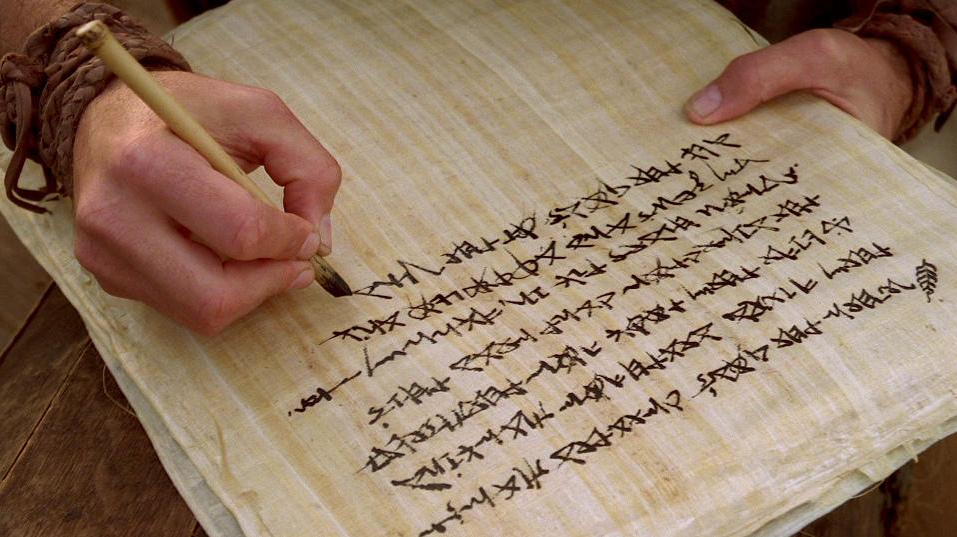
It seems that writing was not much employed for any of the ordinary and private purposes of life by the people of Greece until the article called papyrus was introduced among them. This took place about the year 600 before Christ, when laws began first to be written. Papyrus, like the art of writing upon it, came originally from Egypt. It was obtained from a tree which it seems grew only in that country. The tree flourished in the low lands along the margin of the Nile. It grew to the height of about ten feet. The paper obtained from it was formed from a sort of inner bark, which consisted of thin sheets or pellicles growing around the wood. The paper was manufactured in the following manner. A sheet of the thin bark was taken from the tree, was laid flat upon a board, and then a cross layer was laid over it, the materials having been previously moistened with water made slightly glutinous. The sheet thus formed was pressed and dried in the sun. The placing of two layers of the bark in this manner across each other was intended to strengthen the texture of the sheet, for the fibers, it was found, were very easily separated and torn so long as they lay wholly in one direction. The sheet when dry was finished by smoothing the surface, and prepared to receive inscriptions made by means of a pen fashioned from a reed or a quill.
In forming the papyrus into books it was customary to use a long sheet or web of it, and roll it upon a stick, as is the custom in respect to maps at the present day. The writing was in columns, each of which formed a sort of page, the reader holding the ends of the roll in his two hands, and reading at the part which was open between them. Of course, as he advanced, he continually unrolled on one side, and rolled up upon the other. Rolls of parchment were often made in the same manner.
The term volume used in respect to modern books, had its origin in this ancient practice of writing upon long rolls. The modern practice is certainly much to be preferred, though the ancient one was far less inconvenient than might at first be supposed. The long sheet was rolled upon a wooden billet, which gave to the volume a certain firmness and solidity, and afforded it great protection. The ends of this roller projected beyond the edges of the sheet, and were terminated in knobs or bosses, which guarded in some measure the edges of the papyrus or of the parchment. The whole volume was also enclosed in a parchment case, on the outside of which the title of the work was conspicuously recorded. Many of these ancient rolls have been found at Herculaneum.
For ink, various colored liquids were used, generally black, but sometimes red and sometimes green. The black ink was sometimes manufactured from a species of lampblack or ivory black, such as is often used in modern times for painting. Some specimens of the inkstands which were used in ancient times have been found at Herculaneum, and one of them contained ink, which though too thick to flow readily from the pen, it was still possible to write with. It was of about the consistency of oil.
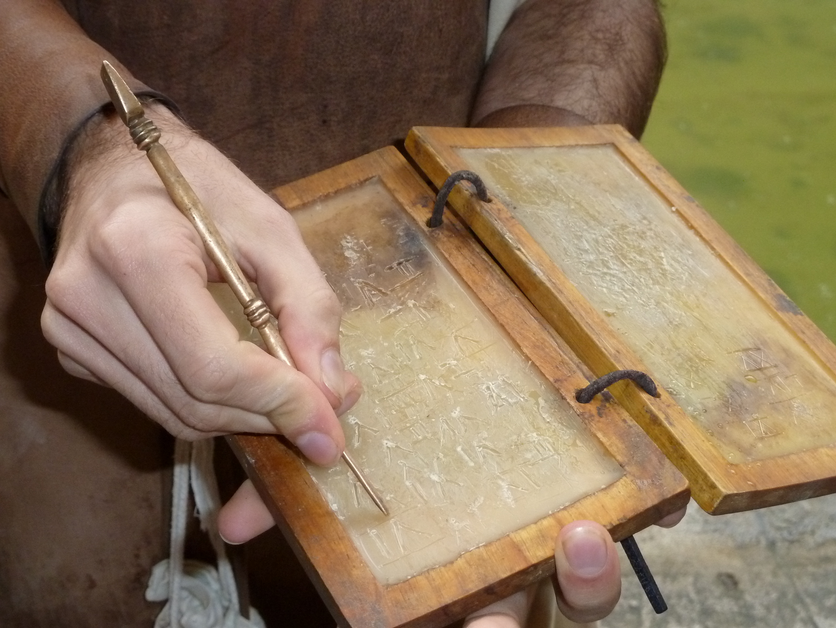
These rolls of papyrus and parchment, however, were only used for important writings which it was intended permanently to preserve. For ordinary occasions tablets of wax and other similar materials were used, upon which the writer traced the characters with the point of a steel instrument called a style. The head of the style was smooth and rounded, so that any words which the writer wished to erase might be obliterated by smoothing over again, with it, the wax on which they had been written.
Such is a brief history of the rise and progress of the art of writing in the States of Greece. Whether the phonetic principle which Cadmus introduced was brought originally from Egypt, or from the countries on the eastern shore of the Mediterranean sea, can not now be ascertained. It has generally been supposed among mankind, at least until within a recent period, that the art of phonetic writing did not originate in Egypt, for the inscriptions on all the ancient monuments in that country are of such a character that it has always been supposed that they were symbolical characters altogether, and that no traces of any phonetic writing existed in that land. Within the present century, however, the discovery has been made that a large portion of these hieroglyphics are phonetic in their character; and that the learned world in attempting for so many centuries, in vain, to affix symbolical meanings to them, had been altogether upon the wrong track. The delineations, though they consist almost wholly of the forms of plants and animals, and of other natural and artificial objects, are not symbolical representations of ideas, but letters, representing sounds and words. They are thus precisely similar, in principle, to the letters of Cadmus, though wholly different from them in form.
To enable the reader to obtain a clearer idea of the nature of this discovery, we give on the adjoining page some specimens of Egyptian inscriptions found in various parts of the country, and which are interpreted to express the name Cleopatra, a very common name for princesses of the royal line in Egypt during the dynasty of the Ptolemy’s. We mark the various figures forming the inscription, with the letters which modern interpreters have assigned to them. It will be seen that they all spell, rudely indeed, but yet tolerably distinctly, the name CLEOPATRA.
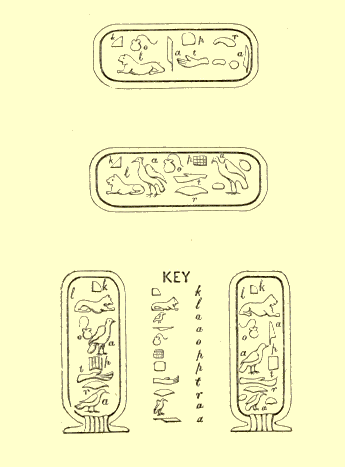
By a careful examination of these specimens, it will be seen that the order of placing the letters, if such hieroglyphical characters can be so called, is not regular, and the letter a, which is denoted by a bird in some of the specimens, is represented differently in others. There are also two characters at the close of each inscription which are not represented by any letter, the one being of the form of an egg, and the other a semicircle. These last are supposed to denote the sex of the sovereign whose name they are connected with, as they are found in many cases in inscriptions commemorative of princesses and queens. They are accordingly specimens of symbolic characters, while all the others in the name are phonetic.
It seems therefore not improbable that the principle of forming a written language by means of characters representing the sounds of which the words of the spoken language are composed, was of Egyptian origin; and that it was carried in very early times to the countries on the eastern shore of the Mediterranean sea, and there improved upon by the adoption of a class of characters more simple than the hieroglyphics of Egypt, and of a form more convenient for a regular linear arrangement in writing. Moses, who spent his early life in Egypt, and who was said to be learned in all the wisdom of the Egyptians, may have acquired the art of writing there.
However this may be, and whatever may be the uncertainty which hangs over the early history of this art, one thing is certain, and that is, that the discovery of the art of writing, including that of printing, which is only the consummation and perfection of it,—the art by which man can record language, and give life and power to the record to speak to the eye permanently and forever—to go to every nation—to address itself simultaneously to millions of minds, and to endure through all time, is by far the greatest discovery, in respect to the enlargement which it makes of human powers, that has ever been made.

